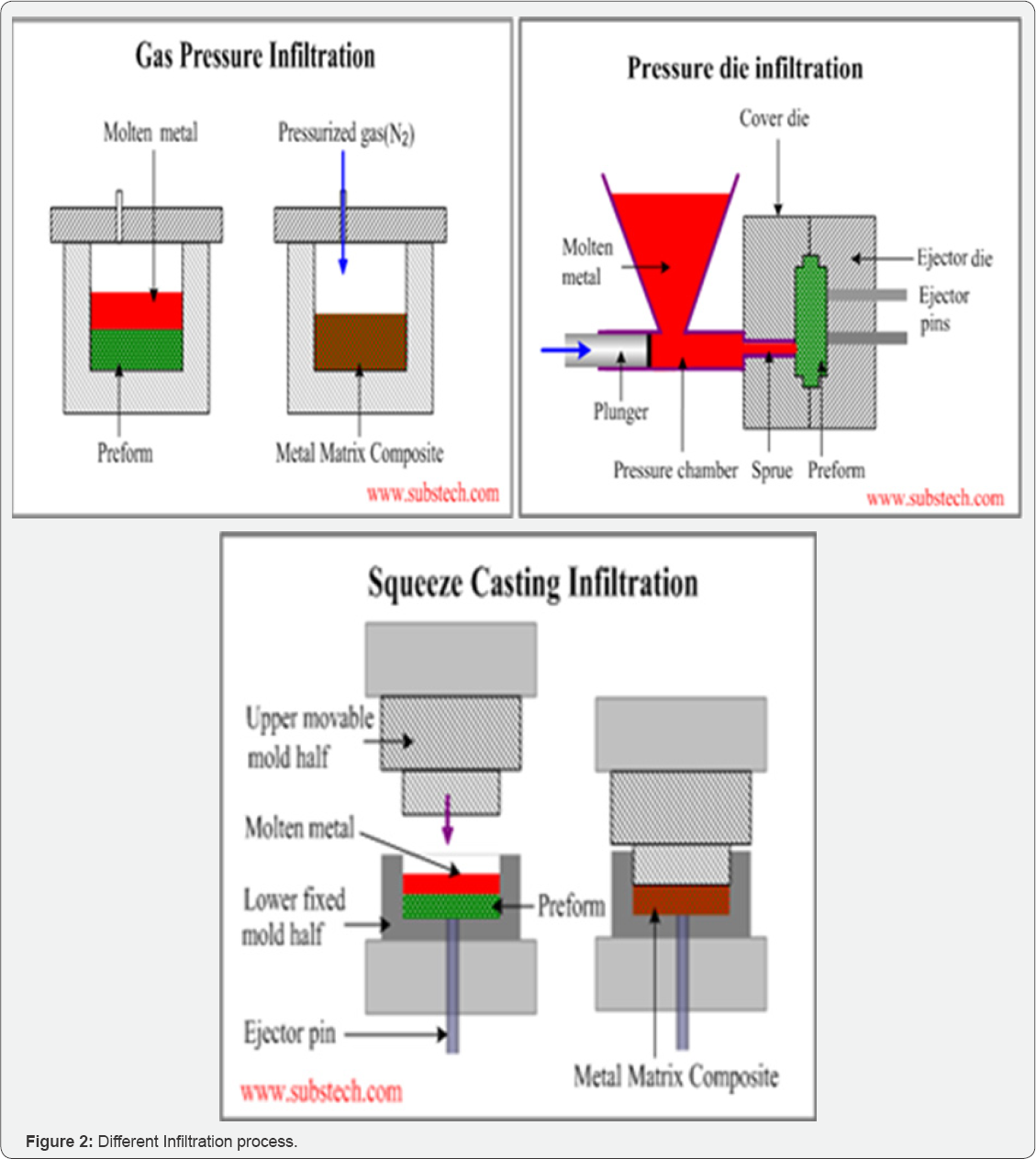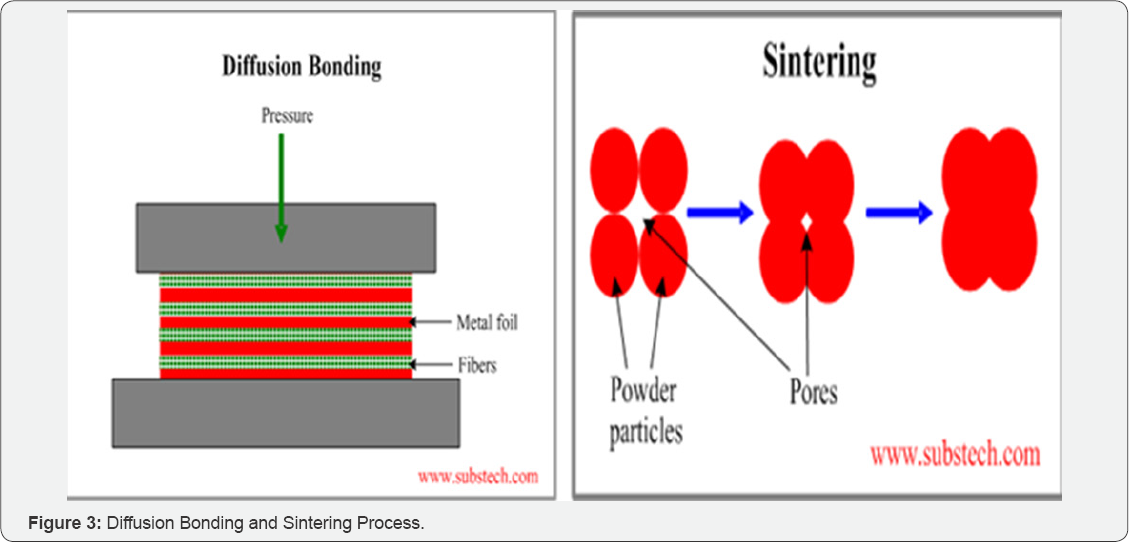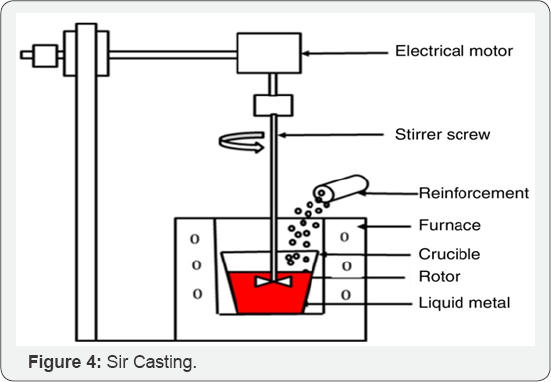A Review on Secondary Process of Hot Extrusion on Aluminum Metal Matrix Composite
Abdul Nazeer1* and Mir Safiulla2
1Research Scholar, Mechanical Engineering, Ghousia college of Emgineering, Ramnagaram, Karnataka, India
2Professor & Head R& D, Mechanical Engineering, Ghousia college of Emgineering, Ramnagaram, Karnataka, India
Submission: April 22, 2018; Published: May 02, 2018
*Corresponding author: Abdul Nazeer, Research Scholar, Mechanical Engineering, Ghousia college of Emgineering, Ramnagaram, Karnataka, India, Email: nazeer0301@gmail.com
How to cite this article: Abdul N, Mir Safiulla. A Review on Secondary Process of Hot Extrusion on Aluminum Metal Matrix Composite. JOJ Mater Sci. 2018; 4(4): 555642. DOI: 10.19080/JOJMS.2018.04.555642
Abstract
Metal matrix composites (MMCs) have made a lot attention in engineering materials due its significantly improved properties including high specific strength, specific modulus, damping capacity and good wear resistance compared to unreinforced alloys. Recent developments actives are carried on processing of Aluminum metal matrix composite Since in last few year lot of work is carried on AMC's. The present paper aims to summarize different processing methods and emphasis is given on effect of hot extrusion as a secondary process of aluminum Al6061 and stir casting processing technique. Extensive applications of cast composite has been found in automotive, aerospace field, Transportation and other engineering industries.
Keywords: Aluminum matrix composite; Stir Casting; Extrusion
Abbreviations: MMCs: Metal Matrix Composites; PMCs: Polymer Matrix Composites; CMCs: Ceramic Matrix Composites
Introduction
With rapid change in technology and recent development in engineering materials and there processing technique have made an engineer to replace the conventional material with advance materials in order to increase weight to strength ratio, easy processing technique, advance high resistance to atmospheric changes, Nowadays engineers have came up with lot of development in structural materials in order for application mainly in aerospace and automotive industries Properties like high specific strength, stiffness, better wear resistance and improved elevated temperature properties compared to the conventional metals and alloys. Composite materials have almost replaced the conventional material due to its very good mechanical, chemical, wear properties tribiological properties and its very high strength to weight ratio, easy of manufacturing. As these composite material have broadly classified into three sub division namely Polymer Matrix Composite, Metal Matrix Composite and Ceramic Matrix Composite. Metal matrix composite (MMC) Aluminum alloys are widely used in aerospace and automobile industries due to their low density and good mechanical properties, better corrosion resistance and wear, low thermal coefficient of expansion as compared to conventional metals and alloys. The properties of monolithic materials are improved with the addition of reinforcements. Aluminum, copper, magnesium and titanium are a few examples of matrix materials and SiC, Al2O3, TiB2, WC, CNTs are a few examples for reinforcing secondary phase materials [9]. Addition of reinforcement SiC to alumina leads to improvement in hardness and wear resistance, thus increasing its applicability. Many processing technique are available for MMC's but most widely used technique is Stir casting method. Here Stir Casting method is implemented for the fabrication of Aluminum matrix composites [1]. In order to change in properties of Metal matrix composite are subjected to under the secondary processing techniques like forging, rolling extrusion etc. here we focusing on effect of Aluminum metal matrix composite when subjected to hot extrusion and it was found that with Equal channel angular extrusion desirable enhancement in material properties is achieved due to ultra-fine grain refinement [2]. For uniform dispersion of material blade angle should be 45° or 60°, For good wet ability we need to keep operating temperature at semisolid stage i.e. 630o for Al (6061). At full liquid condition it is difficult uniform distribution of the reinforcement in the molten metal. Preheating of mould helps in reducing porosity as well as increases mechanical properties [1]. Improved die design and surface treatment will play an important role in the economic production of high quality composites with excellent structures and properties [3,4]. Two new approaches (Cold Forging and Thixo forging) towards an improvement of the forming behavior of metal matrix composites (MMC) have been investigated. Cold Forming was performed with two aluminum based MMCs (A16082 with Al2O3 short fibers and A16061 with A12O3 particles) [5-7]. Some ofthe work has done on hot rolling and aging due hot rolling one can achieve large plastic deformation and it is found that Tensile strength and hardness have increased and wear rate is decreased [8]. Further the effort was made on Effect of Secondary Processing and Nanoscale Reinforcement on the Mechanical Properties of Al-TiC Composites with an average of 45nm, reinforcement were synthesized using low energy planetary ball mill followed by hot extrusion Microstructural characterization of the materials results uniform distribution of reinforcement, grain refinement . Properties characterization results that hardness nano-TiC particulates has increased, elastic modulus, 0.2% yield strength [9,10].
a) Primary Processing of Composites: Production of composite material by combining ingredient materials (e.g. powdered metal and loose ceramic particles, or molten metal and fibre preforms), but not necessarily to final shape or final microstructure
b) Secondary Processing: Processing steps which follow primary processing, and aim to alter the shape or microstructure of the material (e.g.. shape casting, forging, extrusion, heat-treatment, machining). Secondary processing may change the constituents (phases, shape) of the composite. processing may change the constituents (phases, shape) of the composite.
Composite Material
Composite material is a system of materials consisting of two or more different materials combined at macroscopic level basically consisting of a Matrix phase and a reinforcing phase.
a) Matrix Phase: The primary phase, having a continuous character, is called matrix. Matrix is usually more ductile and less hard phase. It holds the dispersed phase and shares a load with it.
b) Dispersed (Reinforcing) Phase: The second phase (or phases) is embedded in the matrix in a discontinuous form. This secondary phase is called dispersed phase. Dispersed phase is usually stronger than the matrix, therefore it is sometimes called reinforcing phase.
Classification of Composite Based on Matrix Phase
Polymer-matrix composites (PMCs)
Metal-matrix composites (MMCs)
Ceramic-matrix composites (CMCs)
Classification of Composites based on Reinforcing Phase
(Figure 1)

Liquid State Fabrication of Metal Matrix Composites
The methods of liquid state fabrication of Metal Matrix Composites:
i. Stir Casting
ii. Infiltration
iii. Gas Pressure Infiltration
iv. Squeeze Casting Infiltration
v. Pressure Die Infiltration
Infiltration: is a liquid state method of composite materials fabrication, in which a preformed dispersed phase (ceramic particles, fibers, woven) is soaked in a molten matrix metal, which fills the space between the dispersed phase inclusions (Figure 2).

Solid State Fabrication of Metal Matrix Composites
Solid State Fabrication of Metal Matrix Composites: is the process, in which Metal Matrix Composites are formed as a result of bonding matrix metal and dispersed phase due to mutual diffusion occurring between them in solid states at elevated temperature and under pressure. There are two principal groups of solid state fabrication of Metal Matrix Composites:
i. Diffusion bonding
ii. Sintering (powder metallurgy)
Diffusion Bonding: Diffusion Bonding is a solid state fabrication method, in which a matrix in form of foils and a dispersed phase in form of long fibers are stacked in a particular order and then pressed at elevated temperature (Figure 3).

Sintering fabrication of Metal Matrix Composites: is a process, in which a powder of a matrix metal is mixed with a powder of dispersed phase in form of particles or short fibers for subsequent compacting and sintering in solid state.
Vapor Deposition
a)Physical Vapor Deposition: The fiber is passed through a thick cloud of vaporized metal, coating it.
In-Situ Fabrication Technique: Controlled unidirectional solidification of a eutectic alloy can result in a two-phase microstructure with one of the phases, present in lamellar or fiber form, distributed in the matrix. With all the processing techniques the most commonly used technique is STIR Casting because of its prominent and economical, the technology is relatively simple. Further we will focusing on Stir casting.
Stir Casting - Fabrication of MMCs

a) Stir Casting: is a liquid state method of composite materials fabrication, in which a dispersed phase (ceramic particles, short fibers) is mixed with a molten matrix metal by means of mechanical stirring. Stir casting of metal matrix composites was initiated in 1968, when S. Ray introduced alumina particles into an aluminum melt by stirring molten aluminum alloys containing the ceramic powders [11,12]. A typical stir casting process is illustrated in Figure 4 [13]. Mechanical stirring in the furnace is a main component of this process. The molten alloy, and ceramic particles, can then be used for die casting, permanent mold casting, or sand casting. The cast composites are sometimes further extruded to improve the mechanical tribological properties and to reduce porosity [2].
b) Two Step Mixing: The recent advancement in stir casting is two step mixing where in matrix material is heated upto liquid stage abd cooled down to such a temperature wherein it is in semi solid region. At this point the preheated reinforcement is added and mixed thoroughly and heated again to liquid state and mixed continuously with stirrer. The resulting microstructure found to more uniform as compared conventional method [2].
Stir Casting Is Characterized by the Following Features
a) Stir casting is suitable for manufacturing composites with up to 30% volume fractions of reinforcement.
b) Distribution of dispersed phase throughout the matrix is not perfectly homogeneous.
c) There are local clouds (clusters) of the dispersed particles (fibers).
d) There may be gravity segregation of the dispersed phase due to a difference in the densities of the dispersed and matrix phase.?
e) The technology is relatively simple and low cost.
f) Distribution of dispersed phase may be improved if the matrix is in semi-solid condition.
g) The method using stirring metal composite materials in semi-solid state is called Rheocasting.
h) High viscosity of the semi-solid matrix material enables better mixing of the dispersed phase.
Designations for Wrought Aluminium Alloys
a) Alloying Element None (99%+ Aluminium) - 1XXX
b) Alloying Element Copper - 2XXX
c) Alloying Element Manganese - 3XXX
d) Alloying Element Silicon - 4XXX
e) Alloying Element Magnesium - 5XXX
f) Alloying Element Magnesium + Silicon - 6XXX
g) Alloying Element Zinc - 7XXX
h) Alloying Element Lithium/Other - 8XXX
For unalloyed wrought aluminium alloys designated 1XXX, the last two digits represent the purity of the metal. They are the equivalent to the last two digits after the decimal point when aluminium purity is expressed to the nearest 0.01 percent. The second digit indicates modifications in impurity limits. If the second digit is zero, it indicates unalloyed aluminium having natural impurity limits and 1 through 9, indicate individual impurities or alloying elements. For the 2XXX to 8XXX groups, the last two digits identify different aluminium alloys in the group. The second digit indicates alloy modifications. A second digit of zero indicates the original alloy and integers 1 to 9 indicate consecutive alloy modifications [14] (Table 1).
An Introduction to Secondary Processing and its Effect
a) Secondary Processing: Processing steps which follow primary processing, and aim to alter the shape or microstructure of the material (e.g.. shape casting, forging, extrusion, heat-treatment, machining). Secondary processing may change the constituents (phases, shape) of the composite.
The Following are the Secondary Processing Methods
i. Shaping
ii. Forging
iii. Extruding
iv. Rolling,
v. Bending
vi. Spinning
vii. Machining
Secondary operations by densification techniques such as forging, extrusion as well as rolling are necessary to reduce or even eliminate pores, break up reinforcement clustering, improve metallurgical bonding and crush brittle oxide films. All of these will be helpful to improving microstructures and mechanical properties of aluminum alloy matrix composites [15].
a) Extrusion: is a process used to create objects of a fixed cross-sectional profile. A material is pushed through a die of the desired cross-section. A large piece of solid metal is pressed through a steel die using an enormous amount of pressure. This pressure is used to force the metal into a desired shape.
b) Cold Extrusion: Cold extrusion is the process done at room temperature or slightly elevated temperatures. This process can be used for most materials-subject to designing robust enough tooling that can withstand the stresses created by extrusion. Examples of the metals that can be extruded are lead, tin, aluminum alloys, copper, titanium, molybdenum, vanadium, steel. Examples of parts that are cold extruded are collapsible tubes, aluminum cans, cylinders, gear blanks.
c) Hot Extrusion: Hot extrusion is done at fairly high temperatures, approximately 50 to 75 % of the melting point of the metal. The pressures can range from 35-700 MPa (5076 - 101,525 psi). Due to the high temperatures and pressures and its detrimental effect on the die life as well as other components, good lubrication is necessary. Oil and graphite work at lower temperatures, whereas at higher temperatures glass powder is used. Typical parts produced by extrusions are trim parts used in automotive and construction applications, window frame members, railings, aircraft structural parts.
Classification of Composites based on Reinforcing Phase
Conclusion
a) With the available literature it has been found that a extensive work is reported to improve the properties of different aluminum based MMC by forming their composites being reinforced with various ceramic materials.
b) It has seen that Stir casting is the most efficient method,
c) With extrusion process the strength and mechanical properties has been increased.
References
- Rajeshkumar Gangaram Bhandare, Parshuram Sonawane M (2013) Preparation of Aluminium Matrix Composite by Using Stir Casting Method 3: 148-155.
- Naik Sachin Ashok, Ravi Kumbar T, Madhusudhan (2016) Investigation on Mechanical and Tribological Properties of 6061 Aluminium - SiC Alloy Fabricated by Stir Casting Method and Equal Channel Angular Extrusion: The Review. IRJET 3(4): 2771-2774.
- (2001) Aluminium mmc extruded products with high stiffness and wear resistance. Seco Aluminium Ltd United Kingdom.?
- Honnaiah C, Satyabodh Raichur, Madhusudan M (2016) A Study on Mechanical Behaviour of Hot Extruded Aluminium based MMC Reinforcedwi th Varying Alumina Particles (A356 Al2O3). IJRET 5(3): 2278-0181.
- Rabindra Behera, Das S, Chatterjee D, Sutradhar G (2011) Forgeability and Machinability of Stir Cast Aluminum Alloy Metal Matrix Composites. JMMCE 10(10): 923-939.
- EZATPOR HR, TORABI PARIZI M, SAJJADI S A (2013) Microstructure and mechanical properties of extruded Al/Al2O3 composites fabricated by stir-casting process. Trans Nonferrous Met Soc China 23(5): 12621268.
- Ramesh CS, Adarsha Hirianiah, Harishanad KS, Naveen Prakash, Noronha (2014) A review on hot extrusion of Metal Matrix Composites (MMC's).
- Reddappa HN, Suresh KR, Niranjan HB, Satyanarayana KG (2014) Effect of Aging on Mechanical and Wear Properties of Beryl Particulate Reinforced Metal Matrix Composites. Journal of Engineering Science and Technology 9(4): 455-462.
- Deborah DL, Chung (2010) Composite Materials Science and Applications (2nd edn.), Springer, New York, USA.
- Senthilkumar V, Balaji A, Hafeez Ahamed (2011) Effect of Secondary Processing and Nanoscale Reinforcement on the Mechanical Properties of Al-TiC Composites. Journal of Minerals & Materials Characterization & Engineering 10(14): 1293-1306.
- James F, Shackelford, Davis William Alexander (2015) Materials Science and Engineering Handbook (4th edn), CRC Press Boca Raton London, New York, USA.
- Mohanakumar KC, Rajshekar S, Ghanaraja S, Ajit Prasad SL (2014) Development and Mechanical Properties of SiC Reinforced Cast and Extruded Al Based MMC's. International conference on advances in manufacturing and materials engineering AMME, pp. 934-943.
- RAY S (1969) M Tech Dissertation. Indian Institute of Technology Kanpur.
- LUO A (1995) Metall Mater Trans A.
- SARAVANAN RA, SURAPPA MK (2000) Mater Sci Engg A.






























